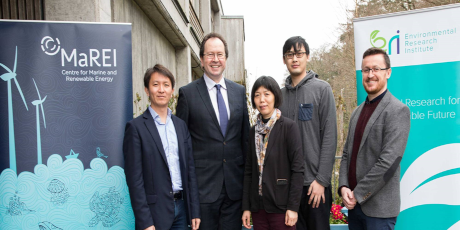CHIMERA project at forefront of International Energy Agency new webinar series 15 Mar 2021

2018 saw the launch of the CHIMERA project, the first project funded in the Energy and Environmental Sustainability category of the Science Foundation Ireland – National Natural Science Foundation of China (SFI-NSFC) Partnership Programme.
Led in Ireland by MaREI/ERI researchers Prof Brian O’Gallachoir, Dr James Glynn, Dr Xiufeng Yue, Siddharth Josh and Vahid Aryanpur, the project aims to develop multi-model innovations in Integrated Assessment Modelling of Global, Chinese, and Irish energy-economy-environment-climate systems, investigating deep decarbonisation pathways from the Paris Agreement to the United Nations sustainable development goals.
Now, the outputs from the CHIMERA project are feeding directly into the current series of global webinars from the IEA-ETSAP (The Energy Technology Systems Analysis Program (ETSAP) is one of the longest running Technology Collaboration Programme of the International Energy Agency (IEA)).
In fact Ireland is having a leading role in these webinars by leading the state of the art energy systems modelling that is ongoing within the CHIMERA project and also due to Dr James Glynn of the CHIMERA project representing Ireland at the IEA-ETSAP Technology Collaboration Programme.
You can now watch back the webinars featuring Dr Glynn and the CHIMERA project here.
The webinar zoom recordings are also now available to watch back on the IEA-ETSAP YouTube Channel here:
You may also be interested in registering for the two forthcoming webinars also featuring Dr Glynn and the CHIMERA project:
- 30th March: Modelling high VRES with hourly TS resolution, unit commitment, dispatch and capacity expansion in TIMES.
- May: Incorporating Climate Variations, Fluctuations and Extremes in Energy Systems models. Dr James Glynn is convening a seminar exploring the role of Climate Variations, Fluctuations and Extremes in TIMES energy system models in conjunction with the ISIMIP project that he is also involved in. This webinar will present applications in IEA-ETSAP TIMES from the ISIMIP and CLIM2POWER projects. This is also timely given the events in Texas over the last few weeks.
Dr Glynn will be highlighting the cutting edge methods having hourly power and transport modelling in long term energy systems modelling in the next generation TIMES Ireland model (TIM).
“This approach explicitly models the hourly variations and fluctuating resource dynamics of wind, solar and hydro availability, integrated with the unit commitment (UC) constraints of dispatch fossil generation power plants all balanced with short term and long-term demand variations and fluctuations with capacity expansion. The approach captures the energy system requirements for system flexibility, demand load shifting in the power and electro-mobility sectors as well as intra-day and intra-seasonal energy storage in batteries, pumped hydro storage and hydrogen production and consumption. The webinar section will provide guidance on how to explicitly optimise the characteristics of wind power, solar and hydropower generation at hourly resolution with unit commitment and dispatch with a demonstration in VEDA2. This involves demonstrating hourly Time-Slice definition setup, year fraction, Demand Fractions, unit commitment dispatch parameters, scenario files and corresponding results tables export and visualisation in Tableau. I will also briefly touch on hourly dispatch model run settings (CPLEX, EXPRESS, GUROBI) and the resulting computing hardware requirements (Cloud or Server) CPU and RAM needed to best solve such large sparce TIMES GAMS matrices.”
You can register for these webinars by signing up to the ETSAP newsletter here.